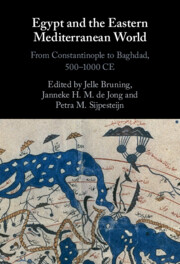Book contents
- Egypt and the Eastern Mediterranean World
- Egypt and the Eastern Mediterranean World
- Copyright page
- Contents
- Figures, Graphs, and Tables
- Notes on Contributors
- Notes on Transliteration, Names, and Dates
- Preface and Acknowledgments
- Additional material
- Introduction
- Part I Political and Administrative Connections
- Chapter 1 Egypt in the Age of Justinian: Connector or Disconnector?
- Chapter 2 At the Crossroads of Regional Settings: Egypt, 500–1000 CE
- Chapter 3 The Frontier Zone at the First Cataract before and at the Time of the Muslim Conquest (Fifth to Seventh Centuries)
- Chapter 4 Islamic Historiography on Early Muslim Relations with Nubia
- Chapter 5 Local Tradition and Imperial Legal Policy under the Umayyads: The Evolution of the Early Egyptian School of Law
- Chapter 6 Ibn Ṭūlūn’s Pacification Campaign: Sedition, Authority, and Empire in Abbasid Egypt
- Part II Economic Connections
- Part III Social and Cultural Connections
- Index
- References
Chapter 2 - At the Crossroads of Regional Settings: Egypt, 500–1000 CE
from Part I - Political and Administrative Connections
Published online by Cambridge University Press: 01 December 2022
- Egypt and the Eastern Mediterranean World
- Egypt and the Eastern Mediterranean World
- Copyright page
- Contents
- Figures, Graphs, and Tables
- Notes on Contributors
- Notes on Transliteration, Names, and Dates
- Preface and Acknowledgments
- Additional material
- Introduction
- Part I Political and Administrative Connections
- Chapter 1 Egypt in the Age of Justinian: Connector or Disconnector?
- Chapter 2 At the Crossroads of Regional Settings: Egypt, 500–1000 CE
- Chapter 3 The Frontier Zone at the First Cataract before and at the Time of the Muslim Conquest (Fifth to Seventh Centuries)
- Chapter 4 Islamic Historiography on Early Muslim Relations with Nubia
- Chapter 5 Local Tradition and Imperial Legal Policy under the Umayyads: The Evolution of the Early Egyptian School of Law
- Chapter 6 Ibn Ṭūlūn’s Pacification Campaign: Sedition, Authority, and Empire in Abbasid Egypt
- Part II Economic Connections
- Part III Social and Cultural Connections
- Index
- References
Summary
Interlocked within two maritime and two terrestrial settings, Egypt’s geopolitical position has been important for its historical development. This chapter focuses on internal developments in Egypt which, although related to its geopolitical position, were mostly influenced by the evolution of the Muslim polity. The discussion attempts to highlight Egypt’s uniqueness as well as the province’s integration within the broader political structure of the caliphate. While the question of integration can be approached from many different angles, my preference has been to focus on some longue durée trends that reflect both Egypt’s geography and the changes related to the emergence of Islam and the consolidation of its power.
- Type
- Chapter
- Information
- Egypt and the Eastern Mediterranean WorldFrom Constantinople to Baghdad, 500-1000 CE, pp. 46 - 72Publisher: Cambridge University PressPrint publication year: 2022



